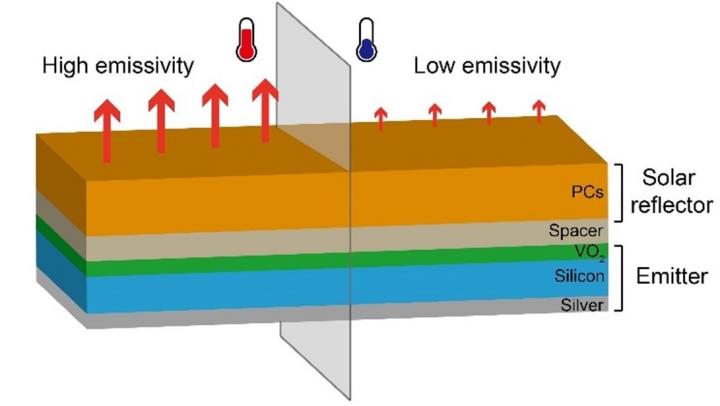In a new publication from Opto-Electronic Advances; DOI https:/
As the impacts of climate change are increasingly felt, thermoregulation technologies that do not consume external energy have attracted considerable attention in the field of energy-saving applications. Radiative cooling has received much research interest for its ability to cool an object even under direct solar illumination. Nanostructured materials, or multi-stacked layers, can be designed to control reflection and emission spectrum to block solar irradiance and/or to emit heat through the atmospheric window.
However, one limitation of radiative cooling for static devices, is that the cooling also occurs in low temperature conditions such as in winter or at night when heating is desired instead. Thus, there has been a strong demand for researchers to develop smart, switchable radiative coolers that cool down objects when the temperature is high but can also heat up in low temperature conditions.
Phase change materials that have distinct phases in response to temperature have been considered good candidates for such requirements. A doped vanadium dioxide (VO2) has a transition temperature at room temperature; the temperature-dependent characteristics of VO2 can be used to design a radiative cooler that cools down at temperatures above the transition temperature while heating up otherwise, without requiring any energy. This passive, but switchable, radiative cooling can directly provide environmentally friendly thermoregulation technology as well as various other applications such as air conditioning and heating.
The authors of this article propose a switchable radiative cooler that satisfies the aforementioned conditions using VO2. They have designed a switchable emitter by stacking VO2 on an insulator-metal layer. The resultant tri-layer structure emits its heat to the atmosphere above the transition temperature. This emitter is combined with a solar reflector, that is composed of several one-dimensional photonic crystals, to form a switchable radiative cooler. Thus, the overall system can block heat from solar energy while emitting thermal energy to the atmosphere.
The authors demonstrated that the switchable radiative cooler maintains a moderate temperature resilient to environmental changes by simulating a cycle of temperature changes under real outdoor conditions. The cooler facilitates self-adaptive thermal control and thus can be implemented in practical applications such as cooling buildings and vehicles.
###
Article reference: Minkyung Kim, Dasol Lee, Younghwan Yang and Junsuk Rho. Switchable diurnal radiative cooling by doped VO2. Opto-Electron Adv 5, 200006 (2021). doi: 10.29026/oea.2021.200006
Keywords: phase change material; photonic crystal; passive thermoregulation; switchable radiative cooling; Fabry-Pérot resonance
Professor Rho’s research group in Pohang University of Science and Technology (POSTECH), South Korea, develops novel optical nanomaterials with a particular interest in sub-wavelength light-matter interaction and device applications. Examples include, but are not limited to, super-resolution imaging, negative index materials, scalable nanomanufacturing methodologies, metasurfaces for colour and hologram generation, topological photonics, acoustics/elastic metamaterials, and machine-learning assisted nanophotonics.
Opto-Electronic Advances (OEA) is a high-quality, open access, peer reviewed research journal that is published by The Institute of Optics and Electronics, Chinese Academy of Sciences. OEA provides a platform for researchers, academicians, professionals, practitioners, and students to impart and share knowledge in the form of high quality empirical and theoretical research papers covering the topics of optics, photonics and optoelectronics.
Since its launch in March 2018, OEA has expanded into a monthly publication schedule. From 2020 OEA is indexed by Science Citation Index Expanded (SCIE) and SCOPUS. From the current Web of Science (WoS) data, OEA expects that the June 2021 Journal Citation Report (JCR) should show that the journal has an Impact Factor of about 10.
More information: http://www.
Editorial Board: http://www.
All issues available in the online archive (http://www.
Submissions to OEA may be made using ScholarOne (https:/
ISSN: 2096-4579
CN: 51-1781/TN
Contact Us: oea@ioe.ac.cn
Twitter: @OptoElectronAdv







